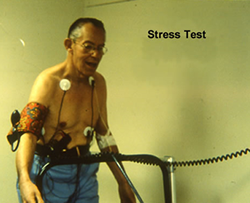Exercise testing was developed in the 1950s with the Bruce Protocol being published in 1963.
The sensitivity of an exercise test for detecting coronary artery disease is 78% with a specificity of 70%.
The aim is to exercise the patient to a target heart rate which is usually 85% of age-predicted maximum. The age-predicted maximum is:
- 220 (for men)
- 210 (for women)
Complication rates are as follows:
- Ventricular tachycardia/ventricular fibrillation (VT/VF) occurs in 1 in 5,000 tests
- Death/myocardial infarction (MI) occurs in 1 in 10,000 tests (0.01%)
A defibrillator and access to resuscitation equipment and staff is essential when performing stress tests. Ideally staff performing tests should be at least Intermediate Life Saving (ILS) trained. Staff performing stress tests should be able to understand and interpret the ECG.
Click on the Exercise Tests tab above to continue.
The three methods are:
Click on each title for more information.
Bruce protocol
- This is the most widely adopted protocol and has been extensively validated
- Starts at 1.7mph and a 10% incline
- Seven stages of 3 minutes each
- Every stage increases speed and incline
Modified Bruce protocol
- This is a submaximal protocol which starts at lower workloads with 3 minute stages
- Often used with the elderly or recent post-MI patients
Bicycle ergometer
- Some people are unable to walk on a treadmill but can use a bicycle
- Three minute stages are performed with gradually increasing workload until the target heart rate is achieved
Prepare the patient in the following way:
- Obtain the patient’s clinical history including indication, risk factors and medication
- Ideally the patient should not eat or smoke for 2-3 hours before the test
- The patient should dress for exercise
- Discontinue B blockers and Digoxin (it interferes with ST segment) for 24 hours if clinically safe to do so
- Explain the procedure to the patient and the need for a target heart rate
Click the Next button below to continue.
